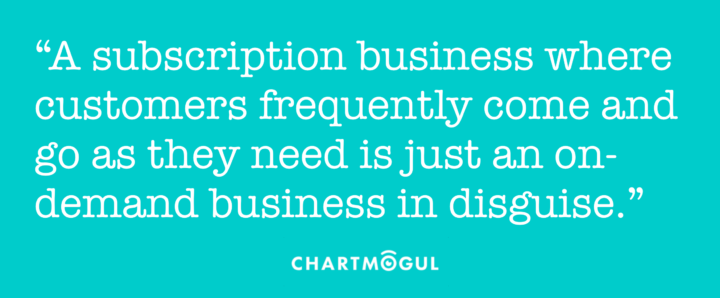The SaaS business model brings with it a wealth of benefits over traditional non-subscription based models. Everything suddenly becomes more measurable and predictable. Furthermore, your revenue recurs and compounds over time. What could be better?! However, subscription models aren’t a great fit for every product out there. There’s a common aspect of some products that can play havoc with metrics and growth: Seasonality.
What is seasonality in SaaS?
Simply put, seasonality is when a customer’s need for your solution is not continuous. On a higher level, it’s all about how revenue flows into your business across a timeframe. The best way to detect it is to look at two metrics: Reactivation MRR and Churned MRR. In a seasonal business, both of these metrics will assume a high proportion of your total MRR for at least part of the year.
There are two key types of seasonality, each exhibiting different characteristics:
1. Regular Seasonality
(Usually caused by external factors)
Example: A service offering an easy way to send greetings cards during the holiday season.
These businesses will show fluctuations in Reactivation and Churn MRR in a predictable pattern. This is because the business has customers who leave and come back due to some external factor – usually calendar events during the year.
In the above example, most customers would subscribe during the run-up to the holiday season each year and unsubscribe (churn) after the holidays are over. This is predictable, and caused by external factors.
2. Irregular Seasonality
(Usually caused by internal factors)
Example: A product offering an easy way for businesses to find and move into new office space.
This type of business will have a consistently high level of Reactivation and Churn MRR throughout the year, and on a per-customer level will be almost completely unpredictable. This is because the reasons for churn and reactivation are not caused by externally visible events (holidays etc.) but rather by internal events experienced by each business.
In this example, the product’s usage on a customer level seems fairly spontaneous. Customers will subscribe at the point where they need to move their company to a new office, and will unsubscribe (churn) once the move is complete.
What’s so bad about this? My customers come back!
On the surface, having a business with some of the characteristics mentioned above might not seem like a desperately bad situation to be in. Actually, in a lot of cases many business can survive — and even thrive — with these high levels of churn and reactivation. After all, people are coming back and paying you when they need the product, so what’s the problem?
It’s largely about risk. Each time those customers churn from your subscription, things are completely out of your control. Investors aren’t hugely fond any kind of seasonal business for this very reason – there is a consistent, ongoing level of risk that may just come back to bite you at some point. Will they come back? What if a better solution enters the market in the meantime? Why would they come back to yours when they have no ties to it — either in the form of a contract commitment, or just in terms of customer loyalty?
It’s also about control. One of the huge benefits of a subscription model in the first place is that you can focus on providing ongoing incremental value, and a high-level user experience to your customers. If those customers are leaving all of the time, you lose the chance to build up any ongoing rapport or connection between them and your brand. They’re not really loyal to you, they just come back when they need you.

If you can move away from this seasonality, you’ll likely solve a lot of problems and start to see many of the often-touted benefits of the subscription model:
- Measurable growth
- Ongoing customer value creation
- Predictability
- Compounding revenue
When Seasonality is acceptable
I recently interviewed founder and CEO of Workable, Nikos Moraitakis. As a SaaS recruitment tool, Workable is one kind of product that commonly attracts seasonal subscriptions. Customers subscribe when they’re going through a recruitment period. This is a typical example of Irregular seasonality, causing a constant high level of both Churn and Reactivation MRR.
The interesting point with Workable is that due to the company’s high-velocity growth, these symptoms are not a problem for them — or at least, not just yet. In other words, if you’re growing fast enough, there are probably better things to focus on.
Read the full interview here:
How can I become less seasonal?
There are several options you have which can help to smooth out revenue spikes and lower any high levels of churn and reactivation caused by seasonality. I’ll warn you – there aren’t many that are easy to implement.
Switch to annual subscriptions only
This is probably the easiest solution to implement, and in many ways the simplest. If customers subscribe to your product once every year for a certain event (the best example of this is a conference ticketing service), then having an annual subscription will force them away from coming and going as they please.
The risk: You might end up driving some customers away who don’t want to commit to a whole year’s subscription upfront. This is inevitable. However, the net positive of having a more controlled subscription model and basically eliminating reactivation means that it’s probably worth it. You need to find the sweet spot for pricing though.
Broaden the use case for your product
Many seasonal businesses are so because the use case for customers is too narrow. This is especially common in early-stage companies where the product hasn’t matured to the level where it offers a range of features for a broader spectrum of target customers. If you can expand the features of your product such that it delivers at least some ongoing value across the whole year, you’re more likely to keep customers from churning.
The risk: You’re going to be moving away from a highly-targeted solution for a highly-specific problem and target customer. Doing this could water down your marketing around the product, making it harder for potential customers to really understand the value you’re delivering.
Try to turn those churns into downgrades
What if you offered a super cheap alternative to churning? A pricing plan that still offered some ongoing value from the product, but at a small scale and a tiny price? Converting your potential churns into downgrades means that you still have a line of dialogue open with your customer. You still have their credit card on file and it’s much easier for them to upgrade again when they need a bigger plan.
The risk: You don’t want to offer a cheap alternative that cannibalises your higher-value plans. The tricky part here is to find a balance of offering just the right (small) amount of value at a price that’s effectively a no-brainer as an alternative to cancelling.
When all else fails…
What if all of the above strategies won’t work for your business and its characteristics? Then it’s time to address the SaaS-sized elephant in the room:
Maybe your product just isn’t a suitable fit for the subscription model.
And maybe that’s fine. Better to see this upfront than to continue to shoehorn the product into a billing model that simply doesn’t make sense. If you can’t offer a steady amount of ongoing value to your customers across a long period of time, you should maybe consider repositioning as a more on-demand transactional solution. There are benefits to those models too.

